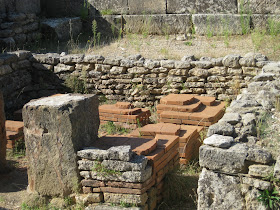Glanum is often described as being the best preserved Gallo-Roman site. That's kind of true, but I think it is more accurate to say that it is one of the few Gallo-Roman sites that could be properly excavated, as it was more or less abandoned in the 3rd century AD.
It has a long history, even for this rather ancient part of the world. First settled in the 6th century BC it seems to have grown up where a road through the mountain pass happened to be near a reliable spring. It started out as a strictly Gallic site, then it was influenced by Greeks from Marsailles, and finally the Romans took it over. A remarkable number of elaborate public buildings sprang up, they in fact seem far out of proportion to the residential base. Finally in the late 3rd century things fell apart. The empire was being buffeted by civil war, economic collapse and barbarian incursions. Basic maintenance of the drainage system broke down and a flood obliterated much of the site. The residents moved, some up the road to the site of modern day St. Remy, others lived on site in much reduced circumstances.
The site is about a mile south of St. Remy. The best way to visit is to enter through the visitor center at the north end, then walk clear through the site to the higher south end. Then turn back and study more carefully. This allows you to see the site more or less as it evolved over time.
Among some very early residential structures at the top of the site is this puzzling structure. Initially thought to be hypocaust heating, the clay tiles are felt to be involved in smoking wine as a preserving tactic.
The sacred spring. Now inhabited by gold fish.
Looking up towards the top of the site.
Like most Gallo-Roman sites Glanum had its inspiration in a local water deity. In this case, Glan. Here is a nifty altar dedicated to Glan, the Glanicae (sort of Glan's heavenly back up band) and Fortuna Redux. It was dedicated by a soldier of the XXI Legion on safe return from a journey. VSLM, dude.
An impressive drain system under the main road. Pretty much essential if you decide to build in a ravine.
Everything is made from limestone, quarried nearby. Nice fossils to be seen. I wonder what the Romans thought of them?
One of the "Gemini Temples" two structures felt to be dedicated to Lucius and Gaius, the adopted sons of Augustus. The columns did not survive antiquity, and have been restored.
Looking down the site, Gemini Temples with the open Forum plaza behind.
An ornate water spout from the public baths. It reminded me of a similar feature in Bath, England. The water in this case did not fill the actual bath but rather a fountain in the exercise area of the baths.
Glanum was an interesting site, but had an odd feel to it. The religious and public buildings outnumbered and physically dominated the actual housing. It would have been interesting to be there when excavations were in progress, as I believe is still the case most summer seasons.









No comments:
Post a Comment
I'll be putting comments into "moderator" format for a while. Sometimes they get a bit off topic. I'll post almost all of them even the One Weird Trick Spamsters if they amuse me. I also answer my email at dagmarsuarez@gmail.com